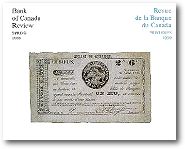Spring 1999

|
Recent developments in the monetary aggregates and their implications by Joseph Atta-Mensah and Loretta Nott
Open outcry and electronic trading in futures exchanges
|
Cover: Merchant’s note, 1837
Since Canada had no steady supply of reliable coinage in the late eighteenth and early nineteenth centuries, Canadian merchants issued their own notes or bons to facilitate trade with their customers. Typically, the value of these notes was tied to the reputation of the issuing merchant and their use restricted to the immediate vicinity of the issuer's business.
Some of the most distinctive merchant notes were those issued in Lower Canada during the financial crisis of 1837. Following the closure of the Bank of the United States, several American banks and businesses went bankrupt. Gold and silver coins grew scarce as people hoarded them, and the banks of Lower Canada, fearful that their coinage would disappear as people redeemed their notes, suspended payments in gold or silver in May 1837.
Merchants responded almost immediately by issuing low-value, crudely designed notes such as this one from Beauharnois, a small community south of Montreal. Many merchant notes were valued in sterling, dollars, and ecus, reflecting the variety of coinage then circulating. For the benefit of the illiterate or semiliterate, some, like this note, carried representations of coins so the bearer could easily recognize the note's value. With the end of the financial crisis in May 1838, these notes quickly disappeared from circulation and became curiosities for collectors.
Approximately four by three inches in size, this bon is part of the National Currency Collection, Bank of Canada.
Photography by James Zagon.




